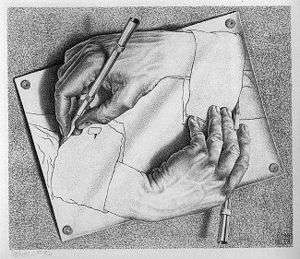Drawing Hands
 | |
| Artist | M. C. Escher |
|---|---|
| Year | 1948 |
| Type | lithograph |
| Dimensions | 28.2 cm × 33.2 cm (11.1 in × 13.1 in) |
Drawing Hands is a lithograph by the Dutch artist M. C. Escher first printed in January 1948. It depicts a sheet of paper out of which, from wrists that remain flat on the page, two hands rise, facing each other and in the paradoxical act of drawing one another into existence. Although Escher used paradoxes in his works often, this is one of the most obvious examples.
It is referenced in the book Gödel, Escher, Bach, by Douglas Hofstadter, who calls it an example of a strange loop. It is also used in Structure and Interpretation of Computer Programs by Harold Abelson and Gerald Jay Sussman as an allegory for the eval and apply functions of programming language interpreters in computer science, which feed each other.
Drawing Hands has been referenced and copied many times by artists in different ways. One common tribute in tech culture is to draw robot hands drawing or building each other[1] or human hands and robot hands drawing each other.[2]
References
Sources
- Locher, J. L. (2000). The Magic of M. C. Escher. Harry N. Abrams, Inc. ISBN 0-8109-6720-0.